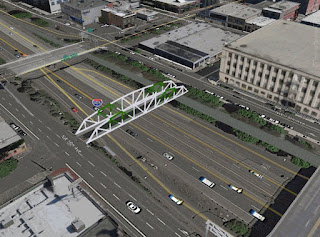Biking in downtown Portland has entered a new
era. Currently, it is not for the faint
of heart. There are bike lanes, streets designated
for bikers, and safe spaces at intersections, but the consistent
proximity to motorists fosters a “high stress” experience that deters over 50
percent of the population from biking.
In addition, numerous traffic controls force more stops and slower
speeds, and sections of Interstate 405 impede travel. In the last month, however, new life has been
given to plans to create a biker’s paradise in the central city.
Last June, I partook in a uniquely Portland event, the Ned
Flanders Greenway Ride. It brought neighbors
and advocates together to assess the prospects of making Flanders Street the
first neighborhood greenway in the inner Northwest section of the city. Donned in green sweaters and mustachios, Zef
Wagner, from the Portland Bureau of Transportation (PBOT), and Reza Farhoodi,
the vice-chair of the Pearl District Planning and Transportation Committee, led
the ride. Their comical appearance added
color to a wonkish two hours. Fifty
participants discussed policy and studied the obstacles that impaired bike
access between the Alphabet District, Tom McCall Park, and bridge access to east Portland.
The I-405 intersection was particularly onerous. It is difficult and dangerous territory for walkers and bikers to navigate. The solution, Wagner and Farhoodi explained, was a decade-old proposal to span the busy freeway with a narrow bike bridge. After a lively discussion, the consensus was this project was the key to providing safe passage for bicyclists between some of the most densely populated neighborhoods in the Pacific Northwest.
In late August, the Oregon Transportation Commission approved $2,877,000 to build the Flanders Bike Bridge. PBOT pledged another $3 million for it from fees paid by developers to mitigate transportation impacts. Plans call for a 24-foot wide structure with two six-foot bike lanes in the middle and six-foot wide sidewalks on each side. Slated to open in 2018, the bridge is expected to average 3,000 crossings as pedestrians and bikers shift from the three high-stress intersections east of Burnside Avenue. Once speed bumps, signage, and diverters are added to Flanders Street, an influx of bikers will spur the number to 9,100. The anticipated increase in users will surpass the trip count on the Hawthorne Bridge, Portland’s most heavily traveled route for commuter biking. |
| Zef Wagner and Reza Farhoodi |
The Flanders Street Greenway is also a key component of the proposed Green Loop, a spoke in the open space network being designed to provide a “low stress” biking experience on both sides of the Willamette River. The Loop is expected to generate a surge of bicycle commuters and carless consumers who will stimulate business and enhance Portland’s green brand. The city is known as a biking Mecca, and with the success of Biketown, the city’s new bike share program, the Green Loop should be a popular tourist draw.
 |
| Green Loop with Flanders Greenway outlined in Orange |
 |
| Installing Bike Share in Downtown |
Once the Flanders Street Bridge and greenway becomes operational the trip time to the eastside will be reduced by two minutes. When the Green Loop comes on line, times will fall further and the Pearl District will be a “biker’s paradise,” according to Roger Geller, Portland’s Bicycle Coordinator. This is the highest designation allotted by bikescore.com, signifying that “daily errands can be accomplished on a bike.”
The Pearl District is already deemed a “walker’s paradise” by walkscore.com. With the new biking network, residents will find it easier to trade the automobile for healthy, less polluting, and cost efficient alternatives. Having this option is also crucial to providing affordable housing, as these projects exclude the expensive additive of automobile parking. Equity, health, and sustainability are inter-related, but getting this mix demands, as Portland demonstrates, a new conception of paradise.
The Pearl District is already deemed a “walker’s paradise” by walkscore.com. With the new biking network, residents will find it easier to trade the automobile for healthy, less polluting, and cost efficient alternatives. Having this option is also crucial to providing affordable housing, as these projects exclude the expensive additive of automobile parking. Equity, health, and sustainability are inter-related, but getting this mix demands, as Portland demonstrates, a new conception of paradise.

No comments:
Post a Comment